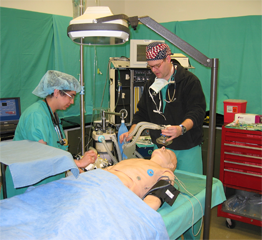Simulation Training
UT Health San Antonio Department of Anesthesiology program incorporates a human patient simulator, offering a unique opportunity to residents and medical students in training to develop and enhance clinical skills through participation in monthly exercises of controlled scenarios. These scenarios are based on real case reports and situations, reconstructed for educational benefits.
Our Training Lab
The Anesthesia Human Simulation Lab is equipped with a Laerdal SimMan Hi Fidelity Human Computerized Simulation Mannequin. The lab is a mock OR setup equipped with cameras and microphones for remote viewing. The concept is to put the resident in an actual OR setting and the actions are observed and controlled from another room, as not to become part of the scenario. The residents find it to be much more realistic and really enjoy learning from SimMan.
The goals of the Anesthesia Simulator Program are:
-
- Provide an innovative educational tool through interactive teaching
- Provide crisis management training
- Improve clinical knowledge through practice
- Build confidence and enhance team performance
- Provide the opportunity to experience clinical scenarios that are infrequent in daily practice, but critical to anesthesia practice
- Provide ACLS training and certification
Medical Student Education
Medical students in their Third and Fourth year Anesthesiology clerkship rotations are introduced to the anesthesia simulator. Under faculty supervision they will be exposed to the principles of pharmacology and physiology in anesthesia and given the opportunity to directly apply these principles within the framework of “real” scenarios without the fear of adverse consequences. Resident Education and Objectives are:
- Learn team principles of complex problem solving, decision making, resource management, and teamwork behaviors during critical care in order to prevent, ameliorate and resolve critical incidents and crisis situations
- Improve medical, cognitive, and social skills in the complexity of an emergency
- Allow participants to build and enhance their capacity for reflection, self-discovery and teamwork
- Build a personalized frame of attitudes, behaviors, and skills which characterize resident performance through highly interactive instruction, critique and feedback in a realistic environment

